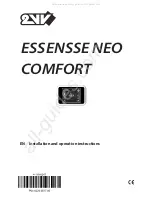
Start-up
TruVu™ VAVB3
-E2
CARRIER CORPORATION ©2022
Installation and Start-up Guide
All rights reserved
63
VAV Reheat
–
Applicable only to single duct terminals with modulating or SCR Electric heat, when set to enable
and reheat is required, the heating device is sequenced first to obtain the
Maximum Heating SAT
before any
increase in airflow. When reheat starts, airflow is maintained at the configured minimum occupied value. Once the
Maximum Heating SAT
is reached and, if a further increase in heating capacity is required, then the airflow is
increased as needed up to the configured
Auxiliary Heat Min Airflow
value.
Parallel fan terminals
–
The controller's
Parallel Fan On Value
determines when the fan turns on to increase
airflow at the zone’s diffusers and prevent cold air from dum
ping into the zone. This is achieved by increasing the
volume and te
mperature of the air exiting the diffusers. If the zone’s airflow control setpoint falls below the
Parallel Fan On Value
, the parallel fan turns on to mix ceiling plenum air with the primary air to increase total
airflow and ventilation to the zone. The fan turns off when the airflow control setpoint rises above this value. If the
zone requires heat while the AHU fan is off, the damper will close while heating is active to prevent reverse flow
out through the terminal inlet.
The fan also starts in Heat mode if the zone is configured for ducted heat as described in
Zone reheat control
(page 63).
Series fan terminals
–
The fan turns on when the air source fan is on as determined by Linkage or in stand-alone
operation by airflow monitoring (the fan is determined to be ON if the measured airflow increases above 20% of
the
Cooling Max Airflow
or if the measured airflow is greater than 50% of the current airflow setpoint). When the
air source starts operation, there is a fan start delay on transition to occupied, based on the
Power Fail Start
Delay
. The terminal's damper fully closes and, after a 15 second delay, the fan starts. This prevents the fan from
rotating backwards. Therefore, each series fan box should have a unique power fail restart delay to avoid closing
all dampers simultaneously.
Damper Actuator(s)
–
The TV-VAVB3-E2's 45 in/lb (5 Nm) actuator has a 154 second full travel time for 90°
operation. For field retrofit applications, the actuator can be adjusted for a damper stroke between 30° and 90°,
and it can be configured to move clockwise (default) or counterclockwise.
If the built-in actuator's torque is insufficient for large damper applications, the TV-VAVB3-E2's analog output can
drive an external, 0-10 volt, high-torque actuator.
Zone reheat control
The TV-VAVB3-E2 can be configured for one of the following
Heat Types
to meet the zone's heating requirements:
•
Modulating Hot Water/Steam
•
Two Position Hot Water/Steam
•
Staged Electric Heat (up to 2 stages with Series/Parallel Fan, up to 3 stages for Single duct)
•
Combination Modulating Baseboard/Staged Electric Heat (up to 2 stages with Series/Parallel Fan, up to 3
stages for Single duct)
All of the above except Combination Modulating Baseboard/Staged Electric Heat can be ducted or non-ducted
(baseboard). For ducted type heat, the controller has a configurable
Maximum Heating SAT
for supply air
temperature control. The controller monitors the SAT when the termi
nal’s ducted heat operates.
If the network provides the OAT, heating can be disabled if the OAT rises above the configured
Heating Lockout
Temperature
.
Modulating Hot Water / Steam Heating Heat
–
The controller modulates a normally closed or normally open hot
water or steam valve connected to the discharge air heating coil. The valve opens and closes as needed to satisfy
the zone's heating requirements. For ducted heat, the terminal’s heat supplem
ents any heat from the primary air
source, but the terminal's SAT is controlled so that it does not exceed the
Maximum Heating SAT
(90°F (32.2°C)
default). For baseboard heating (non-
ducted heat), the valve modulates to keep the zone’s temperature at the
heating setpoint.
















































